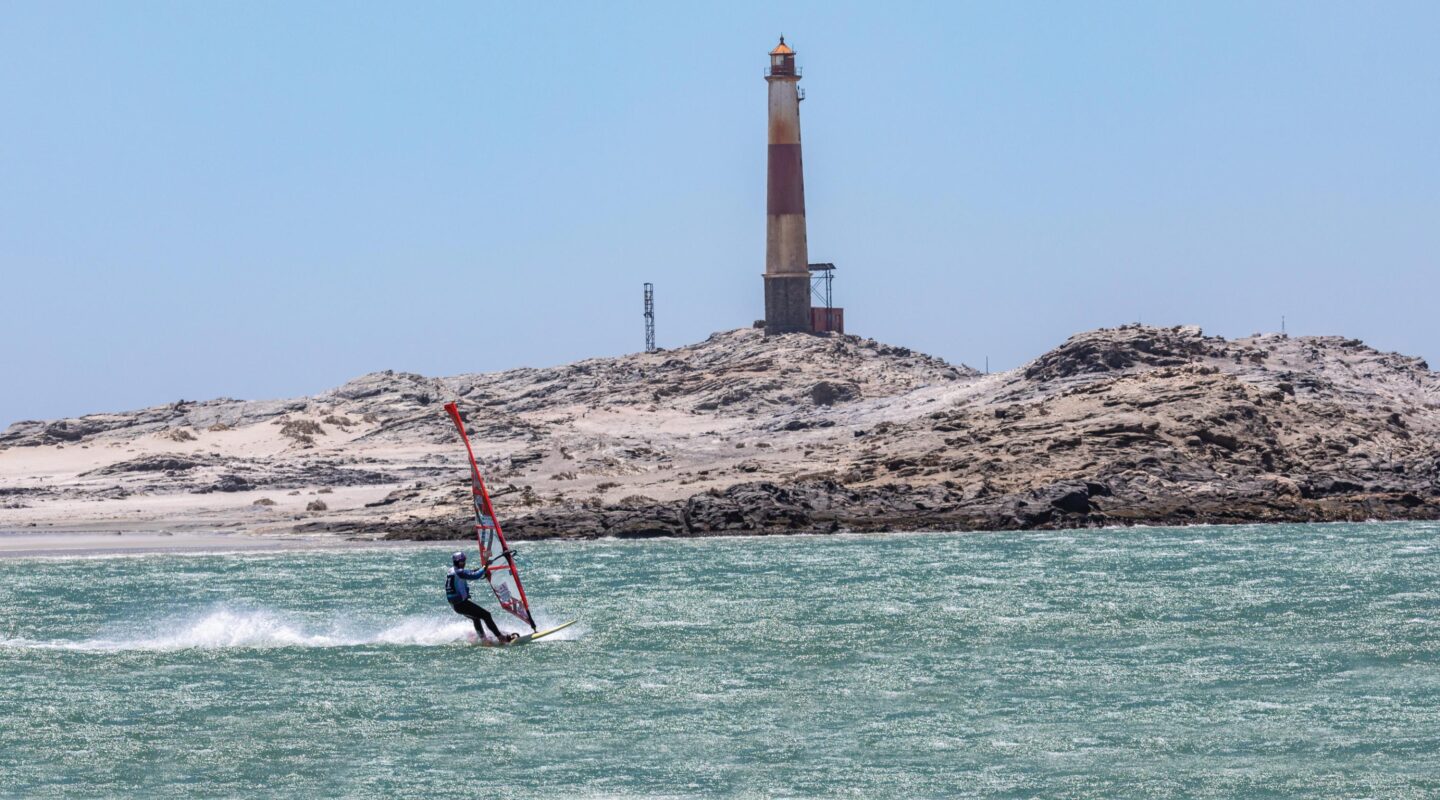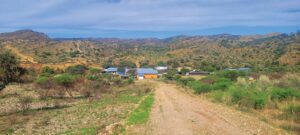


Breaking
the elusive
100
Breaking the elusive
100
It is a typical November day in Lüderitz. The wind is howling. The type of wind where on the B4 you have to dodge the tiny dunes blown onto the tarmac, or when you dare to get out of your vehicle, better be sure to have a good grip on the door handle. Needless to say, in this weather any sane person stays safely indoors and only ventures outside if it is really necessary. Yet, for a handful of speed windsurfers from around the world, gathered just south of the town at Second Lagoon, these conditions are perfect. High winds have helped to break the 50 knot (92.6 km/h) barrier and present the potential to break the elusive record of 100 km/h or just under 54 knots.
Text Le Roux van Schalkwyk | Photographs Le Roux van Schalkwyk
From the Autumn 2022 issue
The Lüderitz Speed Challenge is an annual speed sailing event, held since 2007 in the harbour town. Since its inception, 146 national and 20 world speed sailing records have been set. Last year’s event took place from 18 October to 28 November and, as always, attracted the biggest names in the sport. Participants included Erik Beale, the first person to break 40 knots, as well as national record-holders Farrell O’Shea (UK), Oisìn van Gelderen (Ireland), Hans Kreisel (Netherlands), Gunnar Asmussen (Germany) and Roger Ornvang (Sweden, windsurf and kiteboarding). One man, however, the Danish- Dutch legend of the sport, Björn Dunkerbeck, was out to add another accolade to an already illustrious career.
Dunkerbeck has been speed sailing since 1987 and broke his first open ocean windsurf record in 1992 with a run at 43.30 knots over 500 metres. With 42 World Championship titles under his belt across different formats of the sport, he is the most successful athlete the sport has ever seen. Before the event, he was ranked fourth with a speed of 51.09 knots (94.6 km/h) but had his sights firmly on the 2015 world record of Antoine Albeau of 53.27 knots (98.66 km/h) over 500 metres. He was bent not just on improving that record, but breaking the 100 km/h barrier – an elusive speed which competitors in the sport have slowly been edging closer to over the past years. The fastest that Dunkerbeck had gone up to that point was 53.50 knots (99.08 km/h) for two seconds.
The man-made canal in which the event takes place is essential for the success or failure of riders to better their speeds or even break a world or national record. According to the event organiser, Raeffello Gardelli, improving the canal for better speeds is a continuous learning process. Gardelli, who has been arranging the speed challenge since 2017, says improvements include changing angles of the canal, finding ways to get the perfect profile of the water and putting hessian bags on the right side of the canal for riders to use as guideline to follow down the 500 metre run. The timing system has also changed a lot since 2017. Laser gates and radio systems are now used whereas the previous system required some 800 metres of cable for the two speed cameras.
Chasing his lifelong goal of 100 km/h, Dunkerbeck follows the same routine on each competition day. As soon as the wind picks up, he sets off to Shearwater Bay, behind Dias Point, for some practice runs before moving to Second Lagoon around 14:00 when wind speeds reach sufficient velocity. During the 2021 event, the first few weeks were characterised by relatively low wind speeds, but by 18 November conditions were perfect for Dunkerbeck to break the speed barrier: 103.67 km/h over a two-second time gap as well as holding an average speed of 101 km/h over a 100 metre stretch of water. A momentous achievement and a dream come true. Although still not beating Albeau’s world record of an average speed of 53.27 knots (98.66 km/h) over 500 metres, it means it will only be a matter of time.
The Lüderitz Speed Challenge attracts roughly 35 competitors every year. Only 15 participants are allowed on the canal per day. The daily limit is intended to avoid overcrowding of the canal and gives each rider enough time to do multiple runs. Riders usually book in for a three week period.
The 2021 event saw five of the top competitors delivering runs of an average speed of over 51 knots (94.45 km/h) over 500 metres while there were two maximum speeds exceeding 100 km/h: Dunkerbeck’s 103.67 km/h, followed by 102.34 km/h achieved by Andy Laufer of Germany.
“It’s not always about breaking a world record. It’s also about working on yourself, on how you surf and how you can improve yourself. Just going down the channel is a fantastic feeling. It’s scary somehow. You have to overcome it, you don’t have to overdo it, you just need to take it step by step,” says Gardelli.
The Lüderitz Speed Challenge is the premiere speed record chase for wind and kite surfers, endorsed by the World Sailing Speed Record Council. Lüderitz Nest Hotel is the event’s longest running sponsor and official partner hotel. TNN
More to explore


Discover Airlines launches a new direct flight between Windhoek and Munich





